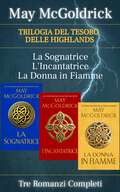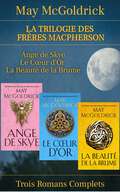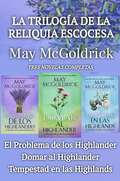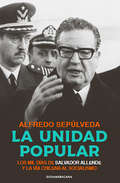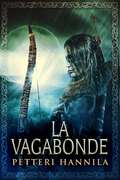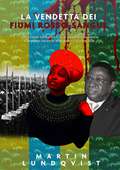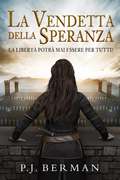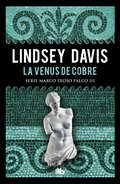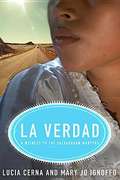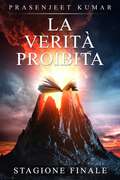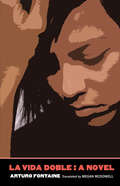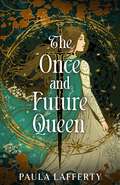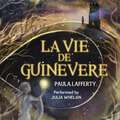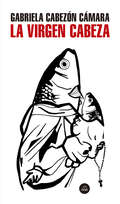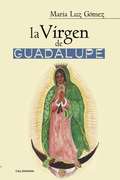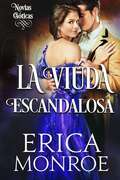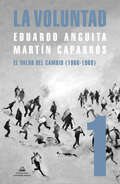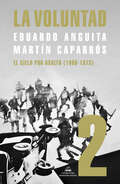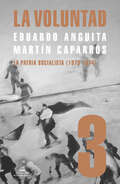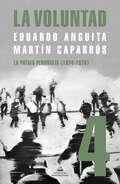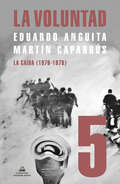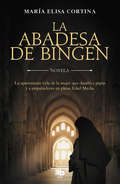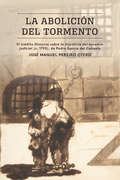- Table View
- List View
La Trilogia del Tesoro delle Highlands: Tre Romanzi Completi: La Sognatrice, L'incantatrice, La Donna In Fiamme (La Trilogia del Tesoro delle Highlands)
by May McGoldrickLA TRILOGIA DEL TESORO DELLE HIGHLANDS Tre Romanzi Completi LA SOGNATRICE, L'INCANTATRICE, LA DONNA IN FIAMME La Trilogia del Tesoro delle Highlands di May McGoldrick cattura le vite e gli amori di tre sorelle scozzesi. Le sorelle Percy hanno in mano un indizio sul tesoro della loro famiglia… e la chiave del cuore di tre guerrieri delle Highlands... LA SOGNATRICE Quando il suo defunto padre fu bollato come traditore del re, Catherine Percy trovò rifugio in Scozia. Ma un caso di scambio di identità la mise in una posizione compromettente con il conte delle Highlands che aveva giurato di proteggerla. Il matrimonio con lui salvò la sua reputazione, ma nulla poté salvarla dalla passione che piegò il suo corpo alla sua volontà... e mandò in frantumi le sue ultime difese! L'INCANTATRICE In fuga dalle persecuzioni del re inglese, Laura Percy si rifugia nelle Highlands scozzesi. Ma quando si ritrovò rapita dal temibile Laird di Blackfearn, tutti i suoi piani ben congegnati furono stravolti. I suoi modi spericolati e selvaggi lasciano Laura in preda alle fiamme... e risvegliarono in lei una passione indomita! LA DONNA IN FIAMME Cosa serve per domare un pirata? Spinta tra le braccia dell'uomo che vuole più del suo cuore, Adrianne Percy si è nascosta nelle isole occidentali, al sicuro dai nemici della sua famiglia, finché le sorelle non mandano un famigerato pirata per riportarla nelle Highlands. Ma quando escogita un piano per liberare la madre rapita, le viene richiesto di sposare il bel mascalzone. E ciò che inizia come una semplice questione di affari si trasforma rapidamente in un desiderio incontrollabile... "UN TESORO ASSOLUTO! Adoro questo libro. Ho appena finito di leggerlo per la seconda volta, anche se non so dire perché non l'ho recensito la prima volta…" - Recensione online del lettore
La Trilogie des Frères Macpherson (Famille Macpherson)
by Jan Coffey May McGoldrickPassion...Trahison...Amour volé ! Des côtes sauvages des îles occidentales de l'Écosse aux champs sanglants de la France, en passant par les cours brillantes de l'Europe, la trilogie Macpherson suit la lutte d'une famille pour l'indépendance de l'Écosse contre le roi des Tudor, Henri VIII. La trilogie complète en un seul volume Ange de Skye Le Cœur d'Or La Beauté de la Brume
La Trilogía de la Reliquia Escocesa: La Trilogía de la Reliquia Escocesa (La Trilogía de la Reliquia Escocesa)
by Jan Coffey May McGoldrickEn 1494, una tormenta hizo naufragar un barco en las rocosas costas del norte de Escocia. Cuatro marineros sobrevivieron, cada uno de los cuales llevaba consigo un fragmento de una tablilla de piedra. Cada pieza confiere un don especial, transmitido de generación en generación. Ahora, tres mujeres son perseguidas por un comandante inglés corrupto que está dispuesto a matar para poseer ese antiguo poder... El Problema de los Highlanders En el corazón de Escocia, un guerrero de las Highlands está a punto de enfrentarse a su destino. En una tierra donde la magia se filtra entre piedras ancestrales y los susurros de criaturas legendarias flotan en el aire frío de las cañadas, Alexander Macpherson, guerrero imbatible, enfrenta el desafío más grande de su vida: ha perdido el rastro de su esposa, una mujer tan misteriosa como cautivadora. Cuando aceptó casarse con la indomable Kenna MacKay para asegurar el dominio de su clan, esperaba enfrentarse a una convivencia difícil… pero jamás que su esposa escapara la noche de bodas, dejando tras de sí un vacío y un anhelo imposible de ignorar. Kenna buscó refugio en un priorato, perfeccionando sus artes curativas, hasta que el destino la empuja de nuevo a los brazos de su esposo. Las chispas vuelan, las voluntades chocan y un amor salvaje resurge. Pero el pasado de Kenna guarda un secreto mortal. Solo unidos, enfrentando miedos y peligros, podrán vencer a quienes quieren destruirlos. Esta vez, Alexander no dejará escapar a su esposa mágica. Domar al Highlander Un cautivador giro al clásico de La Bella y la Bestia. Innes Munro nació con un don extraordinario: puede "leer" el pasado de cualquier persona con solo tocarla. Pero ese regalo es también una pesada carga, que la ha llevado a vivir aislada en el desolado castillo de Girnigoe. Allí conoce a Conall Sinclair, Conde de Caithness, un guerrero marcado por cicatrices de batalla y torturas, y por heridas aún más profundas en su alma. Conall vive recluido, decidido a mantener a todos a distancia… hasta que la presencia ardiente y compasiva de Innes comienza a romper sus muros. Sin embargo, Innes teme que su don sea visto como una maldición. ¿Podrá Conall amar a una mujer que conoce sus secretos más oscuros? Cuando fuerzas externas amenazan con separarlos, deberán elegir entre rendirse al miedo o luchar por un amor capaz de sanar lo imposible. Finalista del Premio RITA. Tempestad en las Highlands
La Unidad Popular: Los mil días de Salvador Allende y la vía chilena al socialismo
by Alfredo SepulvedaA 50 años del gobierno de la Unidad Popular, este es un relato historiográfico y periodístico. En la misma línea de su Breve Historia de Chile, el periodista y escritor Alfredo Sepúlveda reconstruye los mil días del gobierno de la Unidad Popular que llevó a la presidencia al socialista Salvador Allende. Con una amplia investigación en fuentes documentales, Sepúlveda reseña desde la perspectiva de los distintos actores que fueron protagonistas de la vía chilena al socialismo, cuando se cumplen 50 años desde que asumió.
La Vagabonde
by Guillermo Cabello Garcia Petteri HannilaVierra est une jeune femme entêtée des sombres contrées du nord. Sa vie est sur le point de prendre un virage drastique, quand les hommes et les esprits essayent de lui enlever tout ce qu’elle a de plus cher. Mais Vierra ne laissera pas sa vie se consumer dans les flammes et le chaos. Avec une volonté de fer, un esprit aiguisé et un but mortel, elle ne renoncera pas avant d’avoir utilisé toutes ses ressources. Le sort, cependant, réserve encore des surprises à la jeune femme. Elle va devenir La Vagabonde: celle qui erre dans le monde connu à la recherche de sa destinée. Vierra réussira-t-elle à trouver son chemin, en ces temps d'agitation, à surmonter les nombreuses adversités et les ennemis auxquels elle est confrontée, et à revendiquer ce qui lui appartient? La Vagabonde de Petteri Hannila est un roman fantastique historique, profondément enraciné dans l'histoire scandinave et les mythes antiques païens; Un conte de châtiment et de survie.
La Vendetta dei Fiumi Rosso-Sangue.
by Martin LundqvistDopo essere sopravvissuta al genocidio ruandese, Samantha decide di vendicare la sua famiglia. Questo libro segue l'adolescente Samantha Nyamwasa nel corso del suo viaggio attraverso un Ruanda devastato dalla guerra durante il genocidio dei tutsi nel 1994. Samantha sopravvive a stupri, mutilazioni genitali e all'assassinio della sua famiglia. Nonostante tutte queste tribolazioni, rimane ferma e determinata a raggiungere il suo obiettivo, uccidere il colonnello Patrick Bagosora e vendicare la sua famiglia.
La Vendetta della Speranza (Silrith #1)
by P. J. BermanLa libertà potrà mai essere per tutti? Come salvi una nazione dalla tirannia? Quando il Re di Bennvika muore in circostanze misteriose ed un usurpatore straniero di nome Jostan Kazabrus s'impadronisce del trono, imponendo spietatamente la sua volontà sulla popolazione, un triumvirato disunito di leader e dei loro seguaci deve tentare di resistergli. La prima è Silrith, la spodestata Principessa filantropa che ci si aspettava salisse al trono. La seconda è Ezrina, una ribelle vendicativa che desidera disperatamente ribaltare gli anni di oppressione etnica del suo popolo, gli Hentani. Il terzo è Zethun, un piccolo nobile che crede che l'unico modo di lottare per la gente comune sia abolire del tutto la monarchia. Mentre le varie fazioni affrontano la minaccia della tirannia e della persecuzione religiosa, ogni condottiero deve essere pronto a compiere l'estremo sacrificio per la loro causa.
La Venus de cobre (Serie Marco Didio Falco #Volumen 3)
by Lindsey DavisTercera entrega de la fascinante serie ambientada en la Antigua Toma y protagonizada por Marco Didio Falco. Roma, siglo I d.C. Marco Didio Falco, el investigador de la Antigua Roma, encarcelado por el emperador por un imperdonable error contable, odia compartir una celda con un roedor, aunque ser rescatado por su madre es casi tan embarazoso. Su novia de alta alcurnia no puede decidir si lo quiere, y la recompensa de Tito César por los servicios prestados ha quedado en papel mojado. Con la esperanza de una vida mejor, o al menos de un apartamento mejor, acepta nuevos clientes. Entre ellos, acepta trabajar para familiares de un acaudalado promotor inmobiliario, Hortensio, para encontrar a su asesino. Pero lo que Falco descubrirá es un semillero de crímenes en los negocios sin escrúpulos de Hortensio.
La Venus de cobre (Serie Marco Didio Falco #Volumen 3)
by Lindsey DavisTercera entrega de la fascinante y divertida serie de novela histórica ambientada en la Antigua Roma y protagonizada por Marco Didio Falco. Roma, siglo I d.C. Marco Didio Falco, el investigador de la Antigua Roma, encarcelado por el emperador por un imperdonable error contable, odia compartir una celda con un roedor, aunque ser rescatado por su madre es casi tan embarazoso. Su novia de alta alcurnia no puede decidir si lo quiere, y la recompensa de Tito César por los servicios prestados ha quedado en papel mojado. Con la esperanza de una vida mejor, o al menos de un apartamento mejor, acepta nuevos clientes. Entre ellos, acepta trabajar para familiares de un acaudalado promotor inmobiliario, Hortensio, para encontrar a su asesino. Pero lo que Falco descubrirá es un semillero de crímenes en los negocios sin escrúpulos de Hortensio.
La Verdad: A Witness to the Salvadoran Martyrs
by Lucia Cerna Mary Jo IgnoffoA firsthand account of the El Salvador martyrdoms and the process of resettling in the United States by Lucia Cerna, a housekeeper at the UCA, through transcribed interviews; also an academic and politically adept reading of El Salvador's history and the vagaries of the American immigration system by a local scholar and professor.
La Verità Proibita: Stagione Finale (La Verità Proibita #3)
by Prasenjeet KumarSe desideravi che Harry Potter ricevesse un messaggio, continua a leggere... Dio direbbe: Smettila di andare in questi templi lugubri, oscuri e freddi che hai costruito tu stesso e che dici che sono casa mia. La mia casa è nelle montagne, nei boschi, nei fiumi, nei laghi, nelle spiagge. È lì dove io vivo ed esprimo il mio amore per te. — Baruch Spinoza Il governo corrotto della Sidua ha invocato un incantesimo maligno per controllare le menti dei suoi cittadini, così possono nascondere la loro incompetenza e diventare sempre più ricchi. Cosa può annullare questo incantesimo e fermare il governo della Sidua? L'inafferrabile Libro della Verità. Nel frattempo, Drabu, l'unico e solo profeta del Malsia, sta pianificando una massiccia invasione della Sidua. Chi può sventare Drabu? Ancora una volta, lo stesso segretissimo Libro della Verità. Nella storia che prosegue dai libri La Verità Proibita volume I e volume II, Noora, Ila e Yadu continuano la loro epica ricerca dell'illusorio Libro della Verità. A ogni passo, il loro viaggio diventa sempre più pericoloso, impraticabile e assolutamente frustrante. Riusciranno mai a trovare il favoloso Libro della Verità? O vedranno la loro amata patria ridotta ancora una volta in schiavitù? Preparatevi a cavalcare una storia d'avventura sulle montagne russe, piena di incantesimi, giganti di montagna, maghi e intriganti colpi di scena a ogni passo. Assistete all'epica ed eterna battaglia tra una cultura inclusiva e una esclusiva, tra gli adoratori della natura e il cosiddetto unico e vero Dio, e decidete con chi preferite stare. Se vi sono piaciuti Il Signore degli Anelli e Game of Thrones, vi innamorerete anche de La Verità Proibita e del suo potente messaggio di fondo, eternamente valido.
La Vida Doble
by Arturo Fontaine Megan McdowellSet in the darkest years of the Pinochet dictatorship,La Vida Dobleis the story of Lorena, a leftist militant who arrives at a merciless turning point when every choice she confronts is impossible. Captured by agents of the Chilean repression, withstanding brutal torture to save her comrades, she must now either forsake the allegiances of motherhood or betray the political ideals to which she is deeply committed. Arturo Fontaine’s Lorena is a study in contradictions—mother and combatant, intellectual and lover, idealist and traitor—and he places her within a historical context that confounds her dilemmas. Though she has few viable options, she is no mere victim, and Fontaine disallows any comfortable high moral ground. His novel is among the most subtle explorations of human violence ever written. Ranking with Roberto Bolaño and Mario Vargas Llosa on Latin America’s roster of most accomplished authors, Fontaine is a fearless explorer of the most sordid and controversial aspects of Chile’s history and culture. He addresses a set of moral questions specific to Pinochet’s murderous reign but invites us, four decades later, to consider global conflicts today and question how far we’ve come.
La Vie de Guinevere: Arthurian legend meets time travel in this sweeping romantic fantasy (The Lives of Guinevere)
by Paula LaffertyOutlander-meets-Camelot in La Vie de Guinevere - the first book in a lush, big-hearted, time travel romantasy trilogy
La Vie de Guinevere: Arthurian legend meets time travel in this sweeping romantic fantasy (The Lives of Guinevere)
by Paula LaffertySometimes legends don't tell the whole story. After the sudden death of her boyfriend, Vera is content to fade into the background-scrubbing sheets and cleaning bathrooms in a Glastonbury hotel. But when a mysterious guest reveals himself as Merlin and whisks her back to seventh-century Camelot, everything changes. He insists she's not just Vera-she's Guinevere, and only she can undo the curse draining the kingdom's magic and save Camelot from the will of a power-hungry mage.There's just one problem: Vera remembers nothing of her past life. And with Camelot teetering on the edge of collapse, time is running out.As Merlin works to restore her memories, Vera uncovers a tangled history of betrayal, power, and heartbreak. Why does King Arthur recoil at her presence? What truly happened the night the curse was cast? And why does every answer feel like it's tearing her in two?In a kingdom built on legend, Vera must decide who she is-before the past destroys the future.
La Virgen Cabeza
by Gabriela Cabezón CámaraLa historia de amor entre Qüity, una cronista de la sección policial de un diario, y Cleopatra, una travesti que ha abandonado la prostitución desde que se le aparece la Virgen. Siguiendo sus consejos, organiza en la villa El Poso, donde viven, una feliz utopía. «Una de las novelas más aptas a esta efervescencia social de la lengua, y también más bellas y agudas.»Silvia Hopenhayn Exuberante y desbocada, barroca y veloz, exquisita y barriobajera es esta novela. "Pura materia enloquecida de azar", como pensaba que era la vida Qüity, la periodista locuaz que termina enamorada de Cleopatra, una travesti carismática entregada al plan salvador que le dicta la Virgen. Del conurbano bonaerense a Miami, esta santísima y plebeya trinidad, sus hijos, amigos y vecinos encarnarán una rebelión popular y sagrada, villera y delirante. Pero ni los milagros, ni la celebración, ni la música que revienta los pasillos de El Poso protegerán a esta utopía fiestera, anticlasista y transgénero. Publicada por primera vez en 2009, La Virgen Cabeza impactó fuerte en el panorama de la literatura nacional. ¿De quién era esa voz personalísima que inscribía su lengua entre la Odisea, la cumbia, el canon argentino y el romancero español? Desmesurada, su autora, Gabriela Cabezón Cámara, obtuvo inmediatamente el elogio unánime de la crítica y el favor de los lectores hacia su proyecto: una revolución en pleno apogeo.
La Virgen de Guadalupe
by María Luz GómezAparecieron las rosas, y en la tilma la imagen de la Virgen. Trata del Imperio azteca; del descubrimiento de América; de la conquista de México por Hernán Cortés; de las apariciones de la Virgen de Guadalupe al indio Juan Diego; del Virreinato; y, tras una época de mayor o menor enemistad, de la paz entre españoles y aztecas. Por último, de la canonización de Juan Diego por el Papa San Juan Pablo II.
La Viuda Escandalosa (Novias Góticas #3)
by Erica MonroeEl escándalo resulta ser mortal en este Romance Gótico de Regencia... Lady Jemma Forster sabe demasiado bien lo crueles que pueden ser las personas chismosas. Sacrificó su propia reputación para restaurar la reputación de su familia. Su matrimonio de conveniencia con un conde acaudalado significó decirle adiós a la pasión, así como a cualquier oportunidad de compartir su amor con el apuesto policía que hacía que su alma ardiera. Ella vive una vida práctica y tranquila como Condesa de Wolverston. Hasta que su marido es asesinado y el único hombre que puede llevar a sus asesinos ante la justicia es su antiguo amor. Gabriel Sinclair, miembro de los Bow Street Runners[1], se ha pasado los últimos tres años intentando olvidar a la inteligente y hermosa Lady Jemma, quien le rompió el corazón cuando se casó con su mejor amigo. La muerte del Conde de Wolverston vuelve a reunir a Gabriel y a Jemma mientras colaboran para encontrar a su asesino. Su investigación les lleva a las zonas más oscuras y peligrosas de Londres, con amenazas que surgen por todas partes. Son los compañeros perfectos para resolver crímenes, pero ¿pueden ser también compañeros en el amor?
La Voluntad 1. El valor del cambio (1966 - 1969)
by Martín Caparrós Eduardo AnguitaEntre la vida y la muerte, un retrato profundo del día a día de los jóvenes revolucionarios de los 70 y un momento excepcional de la historia argentina. «La Voluntad es un intento de reconstrucción histórica de la militancia política en la Argentina en los años sesenta y setenta. Y, también, la tentativa de ofrecer un panorama general de la cultura y la vida en esos años. La Voluntad es la historia de una cantidad de personas, muy distintas entre sí, que decidieron arriesgar todo lo que tenían para construir una sociedad que consideraban más justa. Elegimos las historias que la componen para que ofrecieran un cuadro de las corrientes y los espacios sociales de la época. La elección siempre se puede discutir; por otro lado, no todos los que contactamos quisieron dar su testimonio. Pero creemos que la veintena de relatos que se cruzan en su trama muestran cómo eran la vida cotidiana, los intereses, odios, convicciones, objetivos, miedos y satisfacciones de los que eligieron ese camino.»Los autores Una historia de la militancia revolucionaria en la Argentina 1966-1969 La mañana del 28 de junio de 1966 la radio anuncia el golpe de Estado de Onganía. Casi tres años después estalla el Cordobazo. Entre estos acontecimientos transcurre este primer volumen de La Voluntad, una obra monumental que, en sus cinco tomos, abarca los años cruciales de una generación de militantes revolucionarios. Testigos y protagonistas de una época decisiva del país y el mundo, sus voces -que reflejan el quehacer de organizaciones políticas y clivajes ideológicos diversos- se complementan con una exhaustiva investigación periodística y una minuciosa reconstrucción histórica. A un cuarto de siglo de su publicación, la delicada escritura de la intimidad de esas vidas públicas hace que este proyecto conserve toda su potencia literaria. Y que siga agitando el debate siempre vital al que invitan los proyectos de liberación. La crítica ha dicho... «Es una obra indispensable. Buena parte de la narrativa de ficción sobre los setentas tiene en La Voluntad una cantera muy importante.»Guillermo Saccomanno «Hay que entender el entusiasmo de esos años, leyendo al pie de la letra los testimonios.»Beatriz Sarlo, Punto de Vista «La edición definitiva de La Voluntad, de Eduardo Anguita y Martín Caparrós, pone en perspectiva lo que significó su publicación hace quince años, cuando por primera vez apareció una historia de la militancia revolucionaria en la Argentina sin eufemismos, una apuesta a combatir la desmemoria desde la escritura.»Mora Cordeu, Télam «Más allá del enorme valor que tuvo en su momento, y que por supuesto mantiene, La Voluntad permite comparar el impacto de una misma historia desde dos contextos. Nadie que haya leído este libro en su primera edición y lo relea hoy lo verá con los mismos ojos. Es otro el mirador de la historia.»Revista Ñ «(La Voluntad) tiene el indudable mérito de haber puesto en primer plano el pasado militante de los detenidos/desaparecidos, que hasta el momento se habían visto aprisionados en su papel de "víctimas".»María Virginia Castro
La Voluntad 2. El cielo por asalto (1969 - 1973)
by Martín Caparrós Eduardo AnguitaEntre la vida y la muerte, un retrato profundo del día a día de los jóvenes revolucionarios de los 70 y un momento excepcional de la historia argentina. «La Voluntad es un intento de reconstrucción histórica de la militancia política en la Argentina en los años sesenta y setenta. Y, también, la tentativa de ofrecer un panorama general de la cultura y la vida en esos años. La Voluntad es la historia de una cantidad de personas, muy distintas entre sí, que decidieron arriesgar todo lo que tenían para construir una sociedad que consideraban más justa. Elegimos las historias que la componen para que ofrecieran un cuadro de las corrientes y los espacios sociales de la época. La elección siempre se puede discutir; por otro lado, no todos los que contactamos quisieron dar su testimonio. Pero creemos que la veintena de relatos que se cruzan en su trama muestran cómo eran la vida cotidiana, los intereses, odios, convicciones, objetivos, miedos y satisfacciones de los que eligieron ese camino.»Los autores Una historia de la militancia revolucionaria en la Argentina 1969-1973 Radicales, peronistas, marxistas, comunistas... Los jóvenes militantes que protagonizan esta obra provienen de distintas clases sociales, pero comparten una época absolutamente singular. De la misión espacial que llega a la Luna a la locura desatada por Los Beatles, de la centralidad de la televisión a las expresiones vanguardistas del arte del Instituto Di Tella, del Che Guevara a los curas tercermundistas, el feminismo, el psicoanálisis... De la lucha política a veces sangrienta y casi siempre multitudinaria en calles y plazas al debate ideológico que reconfigura las formas tradicionales de concebir no solo la sociedad, sino también las relaciones de pareja, la sexualidad y la individualidad. Martín Caparrós y Eduardo Anguita consiguen la hazaña de dar cuenta de toda esa riqueza de experiencias históricas a partir de un conjunto de vidas singulares y verterlas al lenguaje de una novela que no se puede dejar de leer. La crítica ha dicho... «Es una obra indispensable. Buena parte de la narrativa de ficción sobre los setentas tiene en La Voluntad una cantera muy importante.»Guillermo Saccomanno «Hay que entender el entusiasmo de esos años, leyendo al pie de la letra los testimonios.»Beatriz Sarlo, Punto de Vista «La edición definitiva de La Voluntad, de Eduardo Anguita y Martín Caparrós, pone en perspectiva lo que significó su publicación hace quince años, cuando por primera vez apareció una historia de la militancia revolucionaria en la Argentina sin eufemismos, una apuesta a combatir la desmemoria desde la escritura.»Mora Cordeu, Télam «Más allá del enorme valor que tuvo en su momento, y que por supuesto mantiene, La Voluntad permite comparar el impacto de una misma historia desde dos contextos. Nadie que haya leído este libro en su primera edición y lo relea hoy lo verá con los mismos ojos. Es otro el mirador de la historia.»Revista Ñ «(La Voluntad) tiene el indudable mérito de haber puesto en primer plano el pasado militante de los detenidos/desaparecidos, que hasta el momento se habían visto aprisionados en su papel de "víctimas".»María Virginia Castro
La Voluntad 3. La patria socialista (1973 - 1974)
by Martín Caparrós Eduardo AnguitaEntre la vida y la muerte, un retrato profundo del día a día de los jóvenes revolucionarios de los 70 y un momento excepcional de la historia argentina. «La Voluntad es un intento de reconstrucción histórica de la militancia política en la Argentina en los años sesenta y setenta. Y, también, la tentativa de ofrecer un panorama general de la cultura y la vida en esos años. La Voluntad es la historia de una cantidad de personas, muy distintas entre sí, que decidieron arriesgar todo lo que tenían para construir una sociedad que consideraban más justa. Elegimos las historias que la componen para que ofrecieran un cuadro de las corrientes y los espacios sociales de la época. La elección siempre se puede discutir; por otro lado, no todos los que contactamos quisieron dar su testimonio. Pero creemos que la veintena de relatos que se cruzan en su trama muestran cómo eran la vida cotidiana, los intereses, odios, convicciones, objetivos, miedos y satisfacciones de los que eligieron ese camino.»Los autores Una historia de la militancia revolucionaria en la Argentina 1973-1974 El breve período que va de la asunción presidencial de Héctor J. Cámpora el 25 de mayo de 1973 a la muerte de Juan Domingo Perón, su mentor y sucesor, el 1° de julio del año siguiente, marcan el apogeo y ocaso de un sueño. La pesadilla ya se había anunciado en Ezeiza, cuando un sector del justicialismo emboscó y tiroteó a la izquierda del movimiento, que también recibía a su líder después del largo exilio. En esos pocos meses, el vértigo de los acontecimientos cambia el signo ideológico de la época y erosiona a la patria socialista. La velocidad de esos días decisivos -acelerados por el triunfo aplastante de la fórmula Perón-Perón en las urnas y el asesinato de Ignacio Rucci por parte de Montoneros poco después- tiene en Martín Caparrós y Eduardo Anguita a sus mejores cronistas. La crítica ha dicho... «Es una obra indispensable. Buena parte de la narrativa de ficción sobre los setentas tiene en La Voluntad una cantera muy importante.»Guillermo Saccomanno «Hay que entender el entusiasmo de esos años, leyendo al pie de la letra los testimonios.»Beatriz Sarlo, Punto de Vista «La edición definitiva de La Voluntad, de Eduardo Anguita y Martín Caparrós, pone en perspectiva lo que significó su publicación hace quince años, cuando por primera vez apareció una historia de la militancia revolucionaria en la Argentina sin eufemismos, una apuesta a combatir la desmemoria desde la escritura.»Mora Cordeu, Télam «Más allá del enorme valor que tuvo en su momento, y que por supuesto mantiene, La Voluntad permite comparar el impacto de una misma historia desde dos contextos. Nadie que haya leído este libro en su primera edición y lo relea hoy lo verá con los mismos ojos. Es otro el mirador de la historia.»Revista Ñ «(La Voluntad) tiene el indudable mérito de haber puesto en primer plano el pasado militante de los detenidos/desaparecidos, que hasta el momento se habían visto aprisionados en su papel de "víctimas".»María Virginia Castro
La Voluntad 4. La patria peronista (1974 - 1976)
by Martín Caparrós Eduardo AnguitaEntre la vida y la muerte, un retrato profundo del día a día de los jóvenes revolucionarios de los 70 y un momento excepcional de la historia argentina. «La Voluntad es un intento de reconstrucción histórica de la militancia política en la Argentina en los años sesenta y setenta. Y, también, la tentativa de ofrecer un panorama general de la cultura y la vida en esos años. La Voluntad es la historia de una cantidad de personas, muy distintas entre sí, que decidieron arriesgar todo lo que tenían para construir una sociedad que consideraban más justa. Elegimos las historias que la componen para que ofrecieran un cuadro de las corrientes y los espacios sociales de la época. La elección siempre se puede discutir; por otro lado, no todos los que contactamos quisieron dar su testimonio. Pero creemos que la veintena de relatos que se cruzan en su trama muestran cómo eran la vida cotidiana, los intereses, odios, convicciones, objetivos, miedos y satisfacciones de los que eligieron ese camino.»Los autores Una historia de la militancia revolucionaria en la Argentina 1974-1976 ¿Cómo se llega al golpe del 24 de marzo de 1976, la herida que marcaría para siempre un antes y un después en la historia del país? Para entenderlo, Martín Caparrós y Eduardo Anguita siguen el día a día de un grupo de militantes populares desde la muerte de Juan Domingo Perón hasta el derrocamiento de su viuda, Isabel Martínez. Entonces, el poder había quedado en manos López Rega, que despliega sus mortíferos escuadrones de la AAA. Las torturas, los secuestros ylos asesinatos provocan el exilio de artistas, intelectuales y militantes, y anuncian la maquinaria de la desaparición del Terrorismo de Estado. La violencia se impone en todos los aspectos de la vida pública y la tragedia va alcanzando, de un modo u otro, a los protagonistas. La crítica ha dicho... «Es una obra indispensable. Buena parte de la narrativa de ficción sobre los setentas tiene en La Voluntad una cantera muy importante.»Guillermo Saccomanno «Hay que entender el entusiasmo de esos años, leyendo al pie de la letra los testimonios.»Beatriz Sarlo, Punto de Vista «La edición definitiva de La Voluntad, de Eduardo Anguita y Martín Caparrós, pone en perspectiva lo que significó su publicación hace quince años, cuando por primera vez apareció una historia de la militancia revolucionaria en la Argentina sin eufemismos, una apuesta a combatir la desmemoria desde la escritura.»Mora Cordeu, Télam «Más allá del enorme valor que tuvo en su momento, y que por supuesto mantiene, La Voluntad permite comparar el impacto de una misma historia desde dos contextos. Nadie que haya leído este libro en su primera edición y lo relea hoy lo verá con los mismos ojos. Es otro el mirador de la historia.»Revista Ñ «(La Voluntad) tiene el indudable mérito de haber puesto en primer plano el pasado militante de los detenidos/desaparecidos, que hasta el momento se habían visto aprisionados en su papel de "víctimas".»María Virginia Castro
La Voluntad. La caída (1976 - 1978)
by Martín Caparrós Eduardo AnguitaEntre la vida y la muerte, un retrato profundo del día a día de los jóvenes revolucionarios de los 70 y un momento excepcional de la historia argentina. «La Voluntad es un intento de reconstrucción histórica de la militancia política en la Argentina en los años sesenta y setenta. Y, también, la tentativa de ofrecer un panorama general de la cultura y la vida en esos años. La Voluntad es la historia de una cantidad de personas, muy distintas entre sí, que decidieron arriesgar todo lo que tenían para construir una sociedad que consideraban más justa. Elegimos las historias que la componen para que ofrecieran un cuadro de las corrientes y los espacios sociales de la época. La elección siempre se puede discutir; por otro lado, no todos los que contactamos quisieron dar su testimonio. Pero creemos que la veintena de relatos que se cruzan en su trama muestran cómo eran la vida cotidiana, los intereses, odios, convicciones, objetivos, miedos y satisfacciones de los que eligieron ese camino.»Los autores Una historia de la militancia revolucionaria en la Argentina 1976-1978 Muy cerca del Estadio Monumental, donde se jugaban los partidos del Mundial 78, funcionaba la ESMA, uno de tantos centros clandestinos de detención y muerte. Allí no solo se torturaba y mataba; también se operaban los vuelos que lanzaban a sus víctimas vivas al Río de la Plata. Para entonces, miles de militantes trataban de subsistir en la clandestinidad; muchos habían sido secuestrados o asesinados. Enfrentadas y diezmadas, las cúpulas revolucionarias toman decisiones impracticables y no consiguen levantar al pueblo contra un gobierno ilegítimo y violento, cuyo plan económico destruye la industria nacional e inicia el ciclo nefasto del endeudamiento externo. Esta saga monumental culmina entre los gritos de júbilo del triunfo mundialista. Para llegar a escuchar los gritos de dolor harían falta años. Y libros fundamentales como este, que recuperaran las historias de los perseguidos. La crítica ha dicho... «Es una obra indispensable. Buena parte de la narrativa de ficción sobre los setentas tiene en La Voluntad una cantera muy importante.»Guillermo Saccomanno «Hay que entender el entusiasmo de esos años, leyendo al pie de la letra los testimonios.»Beatriz Sarlo, Punto de Vista «La edición definitiva de La Voluntad, de Eduardo Anguita y Martín Caparrós, pone en perspectiva lo que significó su publicación hace quince años, cuando por primera vez apareció una historia de la militancia revolucionaria en la Argentina sin eufemismos, una apuesta a combatir la desmemoria desde la escritura.»Mora Cordeu, Télam «Más allá del enorme valor que tuvo en su momento, y que por supuesto mantiene, La Voluntad permite comparar el impacto de una misma historia desde dos contextos. Nadie que haya leído este libro en su primera edición y lo relea hoy lo verá con los mismos ojos. Es otro el mirador de la historia.»Revista Ñ «(La Voluntad) tiene el indudable mérito de haber puesto en primer plano el pasado militante de los detenidos/desaparecidos, que hasta el momento se habían visto aprisionados en su papel de "víctimas".»María Virginia Castro
La abadesa de Bingen
by María Elisa CortinaLa verdadera historia de la mujer que desafió a papas y emperadores en plena Edad Media. Nacida en una familia de fortuna y linaje, a los tres años de edad Hildegarda de Bingen comenzó a tener visiones acompañadas de dolores tan intensos que parecían llevarla a la muerte. A los catorce años fue encerrada, contra su voluntad, en una celda de barro adosada a las paredes de un monasterio de varones. Allí dedicaría su vida solo a la contemplación del Señor. Pero Dios le tenía preparada otra cosa. Sazonada con ingredientes fantásticos y usando como telón de fondo el mundo monástico y el convulsionado siglo XII, esta novela narra la historia de esa joven que desafiando a su mundo fue abadesa, profetisa y médico. Realizó milagros y exorcismo, se vistió con sedas y joyas, escribió de teología y medicina, compuso música, fundó dos monasterios, predicó en público, desafió al mundo masculino y enfrentó a papas y emperadores siendo una de las personalidades más fascinantes del siglo XII alemán. **Novela ganadora del Premio Caligrama 2018, en la categoría Talento.**
La abadesa de Bingen
by María Elisa CortinaLa verdadera historia de la mujer que desafió a papas y emperadores en plena Edad Media. Nacida en una familia de fortuna y linaje, a los tres años de edad Hildegarda de Bingen comenzó a tener visiones acompañadas de dolores tan intensos que parecían llevarla a la muerte. A los catorce años fue encerrada, contra su voluntad, en una celda de barro adosada a las paredes de un monasterio de varones. Allí dedicaría su vida solo a la contemplación del Señor. Pero Dios le tenía preparada otra cosa. Sazonada con ingredientes fantásticos y usando como telón de fondo el mundo monástico y el convulsionado siglo XII, esta novela narra la historia de esa joven que desafiando a su mundo fue abadesa, profetisa y médico. Realizó milagros y exorcismo, se vistió con sedas y joyas, escribió de teología y medicina, compuso música, fundó dos monasterios, predicó en público, desafió al mundo masculino y enfrentó a papas y emperadores siendo una de las personalidades más fascinantes del siglo XII alemán.**Novela ganadora del Premio Caligrama 2018, en la categoría Talento.**
La abolición del tormento: El inédito Discurso sobre la injusticia del apremio judicial (c. 1795), de Pedro García del Cañuelo (North Carolina Studies in the Romance Languages and Literatures #314)
by José Manuel Pereiro OteroJunto a la erradicacion de la esclavitud y de la pena capital, la abolicion del tormento configura durante el siglo XVIII una de las disputas intelectuales mas incisivas de la Europa continental. Una importante e inedita pieza de esta controversia juridica, politica y social en la Espana de la epoca es el Discurso sobre la injusticia del apremio judicial, donde se argumenta a favor de prohibir este y otros metodos legales de coercion fisica y mental. A mediados de la ultima decada del setecientos, su autor, el abogado Pedro Garcia del Canuelo, trata de publicarlo y busca la mediacion de Manuel Godoy. Sin embargo, el futuro Principe de la Paz rechaza proteger el manuscrito y advierte al autor sobre posibles repercusiones si continua examinando dicho asunto. En consecuencia, aunque el titulo ha pasado al registro historico en contadas referencias indirectas, su contenido se creia perdido. La abolicion del tormento no solamente rescata la figura y el trabajo de su autor, sino que analiza, transcribe y reproduce el texto. Ademas, aparte de estudiar las repercusiones de este debate intelectual en ensayos, dramas, textos narrativos y articulos periodisticos, examina los fundamentos filosoficos y legales de la controversia sobre la tortura juridica en Europa y, particularmente, en Espana. La disputa en la que participa el Discurso sobre la injusticia del apremio judicial refleja las tensiones politicas, juridicas y sociales de la epoca, ya que el debate sobre la legitimidad de la tortura implica considerar planteamientos cuya relevancia no se limita al siglo XVIII. Entre ellos se encuentran, por ejemplo, como se puede articular la relacion entre legalidad y justicia, que criterios se usan para definir a un ser humano, que principios establecen el valor intrinseco de la existencia individual, asi como que circunstancias condicionan la igualdad ante la ley, y cuales son los limites del poder legitimo cuando este suspende los derechos naturales, politicos y civiles del ciudadano. Ampliamente documentado, este estudio es de particular interes para quienes reflexionen sobre los cambios en los procesos legales y en las practicas politicas durante la transicion entre el Antiguo Regimen y el liberalismo moderno.
